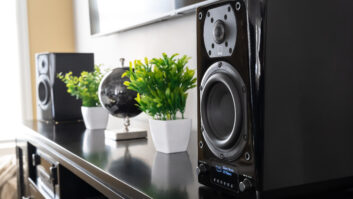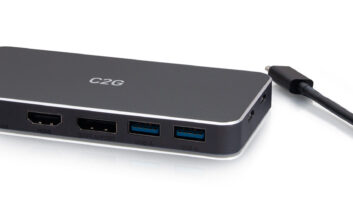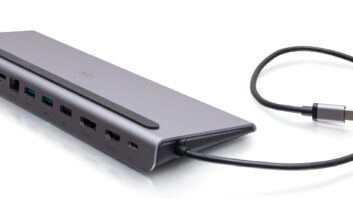
The Artison RCC Nano 1 subwoofer, which is available in black or white, provides even sound dispersion and can be positioned in a variety of locations–including on a bookshelf–thanks to its dual opposable powered woofers.
Let’s just go ahead and get this out of the way at the start: if you haven’t been following the hype, Artison’s new RCC Nano 1 subwoofer is positively itty bitty. It measures in at a mere 7.5 by 8 by 9 inches, and is light enough that it can be held in the palm of one hand, despite its rather beefy build materials.
That fact alone–the Nano 1’s infinitesimal size and weight–would have probably consumed an entire review a few years ago. These days, though, so-called micro subs are… well, not necessarily a dime a dozen–since they tend to be quite a bit more expensive, pound-per-pound, than their larger brethren–but they’re certainly not a rarity anymore. So let’s take just another brief moment to ooh and ahh over how tiny this little sub is, and speak no more of its stature, aside from the occasional comparison and maybe some reiterative marveling near the end of the review.
Because in truth, the Nano 1’s diminutive footprint is actually one of the least interesting things about it, in my opinion. What’s more impressive is that Artison has delivered such a feature-rich, installation-friendly subwoofer for such a reasonable price. And yes, the size of the Nano 1 does factor into its installation flexibility, but it’s far from the only thing that makes this such a versatile sub.
To wit: I cannot remember the last time I came across an affordable subwoofer that included not only an LFE input, but also speaker level inputs, 12-volt trigger control capabilities, a 3.5-millimeter IR input, selectable low-pass filter slope with 12dB/octave and 24dB/octave settings, and infinitely adjustable phase and low-pass frequency controls in lieu of binary toggles. The RCC Nano 1 also comes with all of the accessories you’ll need to tap into these connections, including phoenix connectors for the 12-volt trigger and speaker level inputs, as well as an RCA-to-3.5-millimeter mini jack adapter for the LFE input.
The latter may seem a curious inclusion until you realize that all of the subwoofer’s connectors and most of its controls (aside from volume, standby, and input source selection) are housed in a recessed alcove underneath the subwoofer.
Of course, if you want to tap into the Nano 1’s wireless capabilities, the only thing you’ll have to worry about hiding is the power cord. Artison’s wireless transmitter is a sold-separately $99 purchase, but it’s neat and discreet and super simple to set up, and although it does limit you to LFE input only, I didn’t detect the slightest drop in performance when moving from a wired LFE connection to the wireless input. The wireless receiver, by the way, is built into the aluminum cabinet, so you don’t have to worry about any extra wires or connections on the subwoofer end.
All of this tells you nothing, of course, about how Artison’s miniature sub actually sounds. The first real surprise for me came as I was running the Anthem Room Correction software for my MRX 710 receiver with the Nano 1 in place. I had forgotten to adjust the volume of the sub beforehand, and got an error message when the frequency sweep started pouring out of the Nano 1’s dual-powered, side-firing 6.5-inch woofers. The problem? It was simply too loud. (And this is with a full complement of Bryston speakers serving as the main five channels). In the end, I had to cut the output of the sub by roughly half before it would play well with the rest of the system in my 13-by- 15-foot secondary home theater room.
Spoiler warning: here comes one of the rare references to the Nano 1’s size that I promised to avoid as much as possible in the intro. I couldn’t help in this moment but to compare the Nano 1 to perhaps its most noteworthy competition in the micro-sub market, Sunfire’s Atmos XT, a 1400-watt beast of a thing with roughly the same footprint as the Nano 1 and two of the same-sized drivers (although, in the case of the Atmos XT, one of those drivers is passive). In the same room, I have to crank the output of the Atmos XT to the max to achieve anything approaching reference-level SPLs. The Nano 1 is able to crank out much more volume, with much less power, to boot: 300 watts RMS/900 watts peak.
That isn’t the only difference between the two subs. Overall, I found the Nano 1’s output to be much more musical, more nuanced, and more refined. It drew less attention to itself, and made the bass feel much more like an extension of the main speakers themselves. It’s also one of the rare subwoofers I’ve tested in this room that didn’t make me long for a second, identical model, just to smooth out the response from seat to seat. I found the coverage to be appreciably even and smooth, although it’s worth noting that I did use Anthem Room Correction to even out a few dips and spikes in the upper end of the Nano 1’s frequency range.
The flipside to that is I didn’t find the Nano 1 to be quite as muscular sounding as the Atmos XT. That said, though, when I stopped comparing the two and simply evaluated the Nano 1 on its own terms, I never really found myself missing that hard-hitting kick. The sub still gave plenty of weight to even the most raucous action scenes.
Furthermore, faced with the choice between more tactile impact in action movies and the sort of smooth, musical bass delivered by the Artison RCC Nano 1, my preference is firmly with the latter. Especially when soaking in the sumptuous bass lines of something like “Dialogue – Part Two” from the DVD-Audio release of Chicago V. Here it was easy to forget that there was a subwoofer in the system, and I don’t mean in the sense that the bass was forgettable; it was anything but. I merely mean that the output from the sub so cohesively blended with the rest of the speakers in the system that it didn’t feel as if the low frequencies were coming out of a separate box near the corner of the room. Granted, there were some tunes in my collection that shone a light on the Nano 1’s lack of ultra-low bass output. It rolls off pretty quickly below 35Hz or so, which makes it less than ideal if you or your clients’ musical collections consist mostly of dubstep or hip hop. But I certainly didn’t find it anymore lacking in that respect any number of 8- or even 10-inch subs I’ve auditioned recently.
My only regret is that I didn’t have more time to experiment with placement of the RCC Nano 1. It sounded great in most places I plopped it: in front of my credenza, along the sidewall of the room a few feet from the corner–even on a bookshelf near the front right corner of the room. Yep, this is definitely the first bookshelf subwoofer I’ve ever tested, a feat that’s possible partly because of the vibration-canceling characteristics of the dual opposable powered woofers. That, combined with the built-in wireless technology, makes one’s placement options nearly infinite, assuming you have access to mains power nearby.
In the end, if I have one complaint about the Nano 1, it’s that it does take quite a while to power on, due to all of the digital signal processing technology built into it. That, though, is a–ahem–small price to pay for such a feature-packed, high-performance sub that also just so happens to be this minuscule.
775.783.4770
ArtisonUSA.com
Kudos
The Artison RCC Nano 1 is an incredibly high-performance subwoofer that delivers musical bass and gobs of integrator-friendly options, like 12-vote trigger and IR control inputs, integrated wireless capabilities, and infinitely adjustable low-pass frequency and phase controls.
Concerns
Unsurprisingly, ultra-low bass output isn’t really the Nano 1’s strong point. A bigger concern is that it takes nearly half a minute for the sub to boot up.
Product Specs
► Dimensions: 7.5”(190.5mm) W x 8”(203.2mm) H (including Feet) x 9” (228.6)D (Including Grilles)
► Frequency Response: 32Hz – 160 Hz
► Amplifier Output: 300 watt / 900 watt peak
► Drivers: Dual active 6.5” long throw aluminum drivers
► Built-in wireless input
► High-level inputs
► Low level Input
► 12-volt trigger
► Auto-sensing







